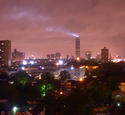After three decades of breakneck urban growth, there are indications of a significant slowdown in the largest cities of China. This is indicated by a review of 2014 population estimates in the annual statistical reports filed individually by municipalities with the National Bureau of Statistics. read more »
Demographics
Declining Population Growth in China’s Largest Municipalities: 2010-2014
- Login to post comments
San Francisco With 200,000 More People — Would we be Better Off?
You want something truly scary? Take a look at these mockups of what San Francisco might look like if we build all the housing that the developers say we need.
According to writer Greg Ferenstein, read more »
2010-2012: More Modest Dispersion Within Metropolitan Areas
American cities seemed to be re-centralizing in the years immediately following the Great Recession, but new American Community Survey data indicates that, contrary to conventional wisdom, Americans continue to disperse though at a much reduced rate. The Census Bureau has just released the five year American Community Survey (2010-2014) small area data used by the City Sector Model to report on population trends within functional sectors of metropolitan areas. read more »
- Login to post comments
Los Angeles: City Of Losers?
When I arrived in Los Angeles four decades ago, it was clearly a city on the rise, practicing its lines on the way to becoming the dominant metropolis in North America. Today, the City of Angels and much of Southern California lag behind not only a resurgent New York City, but also L.A.’s longtime regional rival, San Francisco, both demographically and economically. read more »
- Login to post comments
How Many People Will Live in Africa in 2050 and 2100?
Large declines in fertility will depend on raising female literacy above 80%.
Every few years, the United Nations Population Division releases demographic projections for the entire world and for every country, region and continent. Although the UN’s database is the most used source on demographics, the data is not equally reliable for all countries. read more »
- Login to post comments
Deindustrialization, Depopulation, and the Refugee Crisis
The refugee crisis facing Western nations has begun to peak both demographically and politically. The United Nations has reported that more than 6.5 million Syrians have fled to neighboring countries and Europe, and even nations that until recently welcomed refugees are frantically trying to change immigration policy or protect borders. read more »
2014 Journey to Work Data: More of the Same
The major metropolitan area journey to work data is out, reported in the American Community Survey ‘s 2014 one year edition. The news is that there is not much news. Little has changed since 2010 despite all the talk about “peak car” and a supposed massive shift towards transit. Single occupant driving remains by far the largest mode of transport to work in the 53 major metropolitan areas (with over 1,000,000 population), having moved from 73.5 percent of commutes to 73.6 percent. read more »
- Login to post comments
The Cities Where Your Salary Will Stretch The Furthest 2015
Average pay varies widely among U.S. cities, but those chasing work opportunities would do well to keep an eye on costs as well. Salaries may be higher on the East and West coasts, but for the most part, equally high prices there mean that the fatter paychecks aren’t necessarily getting the locals ahead. read more »
- Login to post comments
When Detroit Stood Tall and Shaped the World
My recent post about how urban planning decisions helped lead to the Motown sound in Detroit was inspired by David Maraniss’ new book Once in a Great City: A Detroit Story.
The book takes a deep dive into Detroit 1963, a city that was, although in some ways already in decline, in others near its zenith.
It’s a great read, in particularly for the depth of characterization. Too often Detroit writing is a story of heroes, villains, and victims. Maraniss rejects that approach and provides mostly nuanced portrayals of Detroiters that allows them to be the actual real, red-blooded human beings that they are. read more »
- Login to post comments
China’s Demographics at a Turning Point
For decades, the decline in China’s birth rate was a big boost for the economy. What now?
This week, schadenfreude could have been a word invented for China experts if you judge by some of the commentary surrounding the country’s lifting of its one-child policy. Most got it right that the legacy of the one-child policy is now a problem for the Chinese economy because of a rapidly rising old-age dependency ratio (green line in the first chart below). This was tacitly acknowledged by the lifting of the policy. read more »
- Login to post comments




















